The Travel Corporation (TTC) Case Study: Marketing Principles Analysis
VerifiedAdded on 2020/06/04
|10
|4228
|41
Case Study
AI Summary
This document presents a mid-semester case study analysis of The Travel Corporation (TTC), focusing on marketing principles and their application. The assignment requires students to demonstrate their understanding of marketing concepts, particularly the marketing concept as a foundation for marketing philosophy, and how TTC interacts with its customers. It examines how TTC develops a unique marketing philosophy, manages situational factors (COMP), and positions its products for different target markets, using brands like Contiki and Trafalgar as examples. The analysis delves into the influence of COMP factors on customer buying decisions and product development, highlighting how TTC caters to both homogeneous and heterogeneous market demands. The document addresses the questions of how TTC has adopted the marketing concept and developed products to suit different target markets, incorporating insights from the provided student's answers and the case study brief. The case study emphasizes the importance of understanding the unit's learning outcomes and applying them to the specific example of The Travel Corporation.
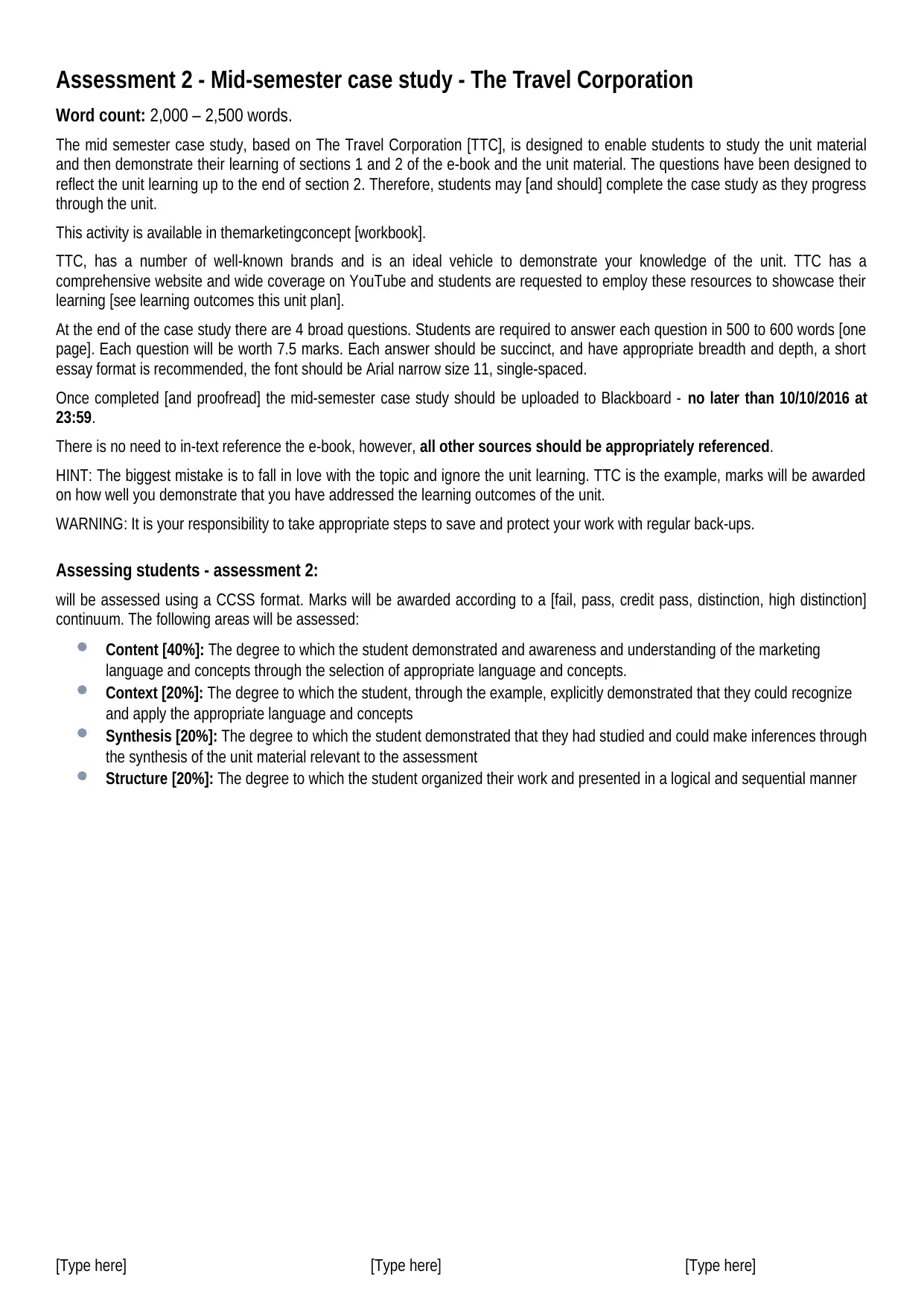
Assessment 2 - Mid-semester case study - The Travel Corporation
Word count: 2,000 – 2,500 words.
The mid semester case study, based on The Travel Corporation [TTC], is designed to enable students to study the unit material
and then demonstrate their learning of sections 1 and 2 of the e-book and the unit material. The questions have been designed to
reflect the unit learning up to the end of section 2. Therefore, students may [and should] complete the case study as they progress
through the unit.
This activity is available in themarketingconcept [workbook].
TTC, has a number of well-known brands and is an ideal vehicle to demonstrate your knowledge of the unit. TTC has a
comprehensive website and wide coverage on YouTube and students are requested to employ these resources to showcase their
learning [see learning outcomes this unit plan].
At the end of the case study there are 4 broad questions. Students are required to answer each question in 500 to 600 words [one
page]. Each question will be worth 7.5 marks. Each answer should be succinct, and have appropriate breadth and depth, a short
essay format is recommended, the font should be Arial narrow size 11, single-spaced.
Once completed [and proofread] the mid-semester case study should be uploaded to Blackboard - no later than 10/10/2016 at
23:59.
There is no need to in-text reference the e-book, however, all other sources should be appropriately referenced.
HINT: The biggest mistake is to fall in love with the topic and ignore the unit learning. TTC is the example, marks will be awarded
on how well you demonstrate that you have addressed the learning outcomes of the unit.
WARNING: It is your responsibility to take appropriate steps to save and protect your work with regular back-ups.
Assessing students - assessment 2:
will be assessed using a CCSS format. Marks will be awarded according to a [fail, pass, credit pass, distinction, high distinction]
continuum. The following areas will be assessed:
Content [40%]: The degree to which the student demonstrated and awareness and understanding of the marketing
language and concepts through the selection of appropriate language and concepts.
Context [20%]: The degree to which the student, through the example, explicitly demonstrated that they could recognize
and apply the appropriate language and concepts
Synthesis [20%]: The degree to which the student demonstrated that they had studied and could make inferences through
the synthesis of the unit material relevant to the assessment
Structure [20%]: The degree to which the student organized their work and presented in a logical and sequential manner
[Type here] [Type here] [Type here]
Word count: 2,000 – 2,500 words.
The mid semester case study, based on The Travel Corporation [TTC], is designed to enable students to study the unit material
and then demonstrate their learning of sections 1 and 2 of the e-book and the unit material. The questions have been designed to
reflect the unit learning up to the end of section 2. Therefore, students may [and should] complete the case study as they progress
through the unit.
This activity is available in themarketingconcept [workbook].
TTC, has a number of well-known brands and is an ideal vehicle to demonstrate your knowledge of the unit. TTC has a
comprehensive website and wide coverage on YouTube and students are requested to employ these resources to showcase their
learning [see learning outcomes this unit plan].
At the end of the case study there are 4 broad questions. Students are required to answer each question in 500 to 600 words [one
page]. Each question will be worth 7.5 marks. Each answer should be succinct, and have appropriate breadth and depth, a short
essay format is recommended, the font should be Arial narrow size 11, single-spaced.
Once completed [and proofread] the mid-semester case study should be uploaded to Blackboard - no later than 10/10/2016 at
23:59.
There is no need to in-text reference the e-book, however, all other sources should be appropriately referenced.
HINT: The biggest mistake is to fall in love with the topic and ignore the unit learning. TTC is the example, marks will be awarded
on how well you demonstrate that you have addressed the learning outcomes of the unit.
WARNING: It is your responsibility to take appropriate steps to save and protect your work with regular back-ups.
Assessing students - assessment 2:
will be assessed using a CCSS format. Marks will be awarded according to a [fail, pass, credit pass, distinction, high distinction]
continuum. The following areas will be assessed:
Content [40%]: The degree to which the student demonstrated and awareness and understanding of the marketing
language and concepts through the selection of appropriate language and concepts.
Context [20%]: The degree to which the student, through the example, explicitly demonstrated that they could recognize
and apply the appropriate language and concepts
Synthesis [20%]: The degree to which the student demonstrated that they had studied and could make inferences through
the synthesis of the unit material relevant to the assessment
Structure [20%]: The degree to which the student organized their work and presented in a logical and sequential manner
[Type here] [Type here] [Type here]
Paraphrase This Document
Need a fresh take? Get an instant paraphrase of this document with our AI Paraphraser
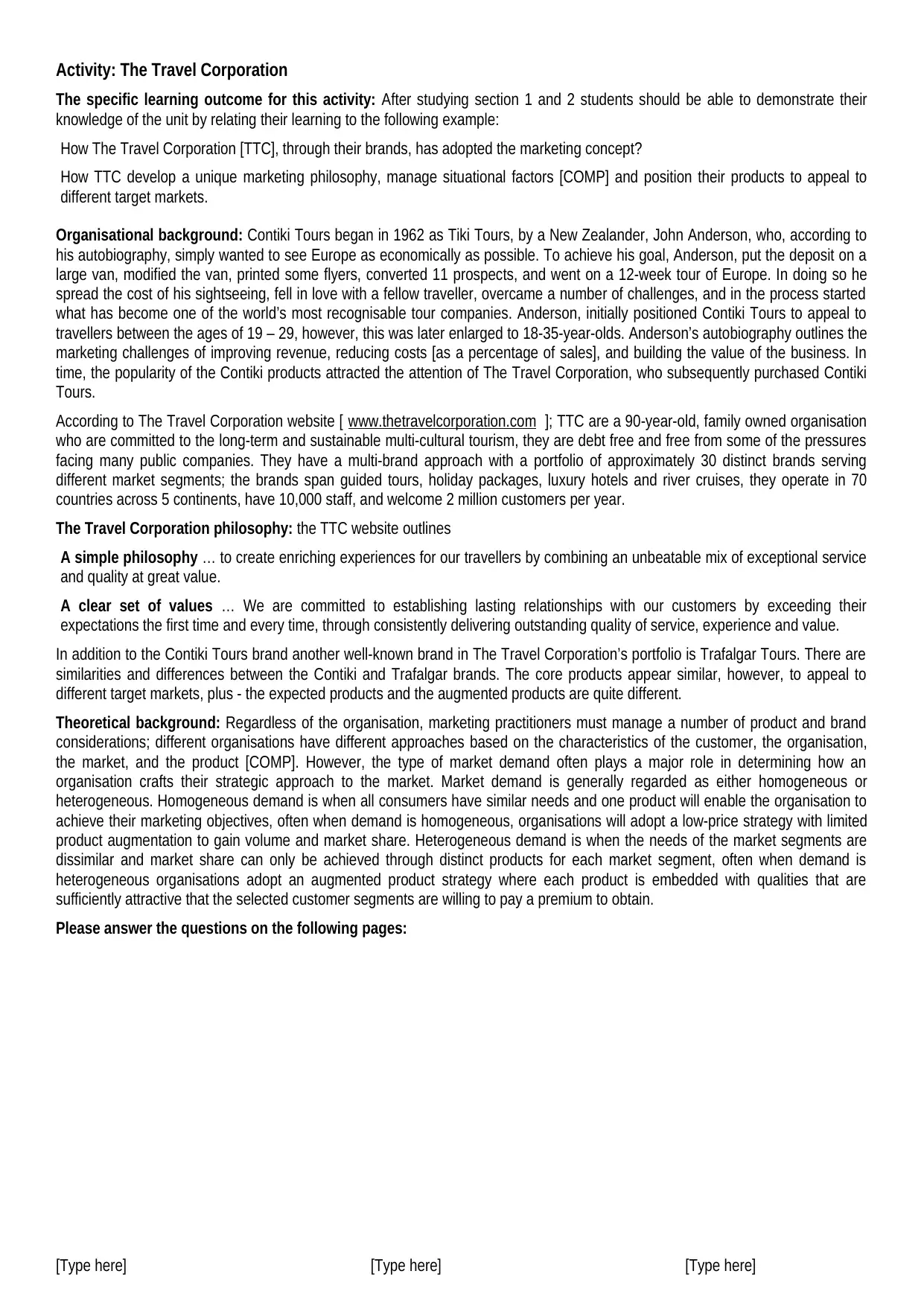
Activity: The Travel Corporation
The specific learning outcome for this activity: After studying section 1 and 2 students should be able to demonstrate their
knowledge of the unit by relating their learning to the following example:
How The Travel Corporation [TTC], through their brands, has adopted the marketing concept?
How TTC develop a unique marketing philosophy, manage situational factors [COMP] and position their products to appeal to
different target markets.
Organisational background: Contiki Tours began in 1962 as Tiki Tours, by a New Zealander, John Anderson, who, according to
his autobiography, simply wanted to see Europe as economically as possible. To achieve his goal, Anderson, put the deposit on a
large van, modified the van, printed some flyers, converted 11 prospects, and went on a 12-week tour of Europe. In doing so he
spread the cost of his sightseeing, fell in love with a fellow traveller, overcame a number of challenges, and in the process started
what has become one of the world’s most recognisable tour companies. Anderson, initially positioned Contiki Tours to appeal to
travellers between the ages of 19 – 29, however, this was later enlarged to 18-35-year-olds. Anderson’s autobiography outlines the
marketing challenges of improving revenue, reducing costs [as a percentage of sales], and building the value of the business. In
time, the popularity of the Contiki products attracted the attention of The Travel Corporation, who subsequently purchased Contiki
Tours.
According to The Travel Corporation website [ www.thetravelcorporation.com ]; TTC are a 90-year-old, family owned organisation
who are committed to the long-term and sustainable multi-cultural tourism, they are debt free and free from some of the pressures
facing many public companies. They have a multi-brand approach with a portfolio of approximately 30 distinct brands serving
different market segments; the brands span guided tours, holiday packages, luxury hotels and river cruises, they operate in 70
countries across 5 continents, have 10,000 staff, and welcome 2 million customers per year.
The Travel Corporation philosophy: the TTC website outlines
A simple philosophy … to create enriching experiences for our travellers by combining an unbeatable mix of exceptional service
and quality at great value.
A clear set of values … We are committed to establishing lasting relationships with our customers by exceeding their
expectations the first time and every time, through consistently delivering outstanding quality of service, experience and value.
In addition to the Contiki Tours brand another well-known brand in The Travel Corporation’s portfolio is Trafalgar Tours. There are
similarities and differences between the Contiki and Trafalgar brands. The core products appear similar, however, to appeal to
different target markets, plus - the expected products and the augmented products are quite different.
Theoretical background: Regardless of the organisation, marketing practitioners must manage a number of product and brand
considerations; different organisations have different approaches based on the characteristics of the customer, the organisation,
the market, and the product [COMP]. However, the type of market demand often plays a major role in determining how an
organisation crafts their strategic approach to the market. Market demand is generally regarded as either homogeneous or
heterogeneous. Homogeneous demand is when all consumers have similar needs and one product will enable the organisation to
achieve their marketing objectives, often when demand is homogeneous, organisations will adopt a low-price strategy with limited
product augmentation to gain volume and market share. Heterogeneous demand is when the needs of the market segments are
dissimilar and market share can only be achieved through distinct products for each market segment, often when demand is
heterogeneous organisations adopt an augmented product strategy where each product is embedded with qualities that are
sufficiently attractive that the selected customer segments are willing to pay a premium to obtain.
Please answer the questions on the following pages:
[Type here] [Type here] [Type here]
The specific learning outcome for this activity: After studying section 1 and 2 students should be able to demonstrate their
knowledge of the unit by relating their learning to the following example:
How The Travel Corporation [TTC], through their brands, has adopted the marketing concept?
How TTC develop a unique marketing philosophy, manage situational factors [COMP] and position their products to appeal to
different target markets.
Organisational background: Contiki Tours began in 1962 as Tiki Tours, by a New Zealander, John Anderson, who, according to
his autobiography, simply wanted to see Europe as economically as possible. To achieve his goal, Anderson, put the deposit on a
large van, modified the van, printed some flyers, converted 11 prospects, and went on a 12-week tour of Europe. In doing so he
spread the cost of his sightseeing, fell in love with a fellow traveller, overcame a number of challenges, and in the process started
what has become one of the world’s most recognisable tour companies. Anderson, initially positioned Contiki Tours to appeal to
travellers between the ages of 19 – 29, however, this was later enlarged to 18-35-year-olds. Anderson’s autobiography outlines the
marketing challenges of improving revenue, reducing costs [as a percentage of sales], and building the value of the business. In
time, the popularity of the Contiki products attracted the attention of The Travel Corporation, who subsequently purchased Contiki
Tours.
According to The Travel Corporation website [ www.thetravelcorporation.com ]; TTC are a 90-year-old, family owned organisation
who are committed to the long-term and sustainable multi-cultural tourism, they are debt free and free from some of the pressures
facing many public companies. They have a multi-brand approach with a portfolio of approximately 30 distinct brands serving
different market segments; the brands span guided tours, holiday packages, luxury hotels and river cruises, they operate in 70
countries across 5 continents, have 10,000 staff, and welcome 2 million customers per year.
The Travel Corporation philosophy: the TTC website outlines
A simple philosophy … to create enriching experiences for our travellers by combining an unbeatable mix of exceptional service
and quality at great value.
A clear set of values … We are committed to establishing lasting relationships with our customers by exceeding their
expectations the first time and every time, through consistently delivering outstanding quality of service, experience and value.
In addition to the Contiki Tours brand another well-known brand in The Travel Corporation’s portfolio is Trafalgar Tours. There are
similarities and differences between the Contiki and Trafalgar brands. The core products appear similar, however, to appeal to
different target markets, plus - the expected products and the augmented products are quite different.
Theoretical background: Regardless of the organisation, marketing practitioners must manage a number of product and brand
considerations; different organisations have different approaches based on the characteristics of the customer, the organisation,
the market, and the product [COMP]. However, the type of market demand often plays a major role in determining how an
organisation crafts their strategic approach to the market. Market demand is generally regarded as either homogeneous or
heterogeneous. Homogeneous demand is when all consumers have similar needs and one product will enable the organisation to
achieve their marketing objectives, often when demand is homogeneous, organisations will adopt a low-price strategy with limited
product augmentation to gain volume and market share. Heterogeneous demand is when the needs of the market segments are
dissimilar and market share can only be achieved through distinct products for each market segment, often when demand is
heterogeneous organisations adopt an augmented product strategy where each product is embedded with qualities that are
sufficiently attractive that the selected customer segments are willing to pay a premium to obtain.
Please answer the questions on the following pages:
[Type here] [Type here] [Type here]

Q1: Outline your understanding of the marketing concept as the foundation of a marketing philosophy. Discuss how this may
influence The Travel Corporation and how it may view and interact with TTC customers.
Many people think that selling and marketing are two similar words but of-course not. Both of them are
distinct to each other and have different concept. Many beneficial things which are taking place in present
world is a result of 12000 years of marketing. Marketing concept is a foundation of merchandising
philosophy and it is employed to describe the thinking manner in a market place along with new strategies
and transformations. Organisations generally develop marketing philosophy with an aim to encounter all
situational factors which are taking place.
According to Drucker, (2017) marketing concept get implemented by consulting three basic
concepts which are: customer orientation, long range customer and social welfare. Thus, on the basis of
this, marketing philosophy concept gets driven out.
Production concept
Product concept
Selling concept
Marketing concept
Social marketing concept
These marketing concepts enable and support in making philosophy through which proper
understanding about all things get done. In an entity, a major focus has to be based on customer
satisfaction by delivering high quality products which leads to meet optimum level and provide some benefit
to society as well (Beverland and Lindgreen, 2010). Thus, this is a basic marketing concept which work as
foundation of marketing philosophy.
The Travel Corporation is free family owned business from last 90 years. It is one of the debt free
business and do not lead to face so much issues and problems which faced by many large public
companies. Company provide vast and wide number of products and services to their ultimate customer
and a proper luxury services as well. Marketing philosophies guide to management through which entity
become able to deal with every situation in an appropriate manner. By providing vast number of options,
organisation customer become able to choose either of them and gain benefit of executed services
(Woodside, 2010). This adaptation of marketing philosophies enable management to interact with users in
an adequate manner. By using production concept, management produce at large scale and reduce the
cost of production. This enable them in attracting customer to choose TTC rather than other by delivery of
services at cheap rates.
TTC also render good quality standardised products to every segment of customer whether they are
belonging to more spent level or small. Along with this, they maintain proper price level with quality
services. Hence, it supports them in interact with all users properly. Further, management start thinking
about their clients as well not as a profit generating tool but as a consumer (Easton, 2010).
A major reason behind success of a firm is that they use whole marketing concept rather focus on
selling of services. TTC promote their products to their ultimate customer and educate them for all services
[Type here] [Type here] [Type here]
influence The Travel Corporation and how it may view and interact with TTC customers.
Many people think that selling and marketing are two similar words but of-course not. Both of them are
distinct to each other and have different concept. Many beneficial things which are taking place in present
world is a result of 12000 years of marketing. Marketing concept is a foundation of merchandising
philosophy and it is employed to describe the thinking manner in a market place along with new strategies
and transformations. Organisations generally develop marketing philosophy with an aim to encounter all
situational factors which are taking place.
According to Drucker, (2017) marketing concept get implemented by consulting three basic
concepts which are: customer orientation, long range customer and social welfare. Thus, on the basis of
this, marketing philosophy concept gets driven out.
Production concept
Product concept
Selling concept
Marketing concept
Social marketing concept
These marketing concepts enable and support in making philosophy through which proper
understanding about all things get done. In an entity, a major focus has to be based on customer
satisfaction by delivering high quality products which leads to meet optimum level and provide some benefit
to society as well (Beverland and Lindgreen, 2010). Thus, this is a basic marketing concept which work as
foundation of marketing philosophy.
The Travel Corporation is free family owned business from last 90 years. It is one of the debt free
business and do not lead to face so much issues and problems which faced by many large public
companies. Company provide vast and wide number of products and services to their ultimate customer
and a proper luxury services as well. Marketing philosophies guide to management through which entity
become able to deal with every situation in an appropriate manner. By providing vast number of options,
organisation customer become able to choose either of them and gain benefit of executed services
(Woodside, 2010). This adaptation of marketing philosophies enable management to interact with users in
an adequate manner. By using production concept, management produce at large scale and reduce the
cost of production. This enable them in attracting customer to choose TTC rather than other by delivery of
services at cheap rates.
TTC also render good quality standardised products to every segment of customer whether they are
belonging to more spent level or small. Along with this, they maintain proper price level with quality
services. Hence, it supports them in interact with all users properly. Further, management start thinking
about their clients as well not as a profit generating tool but as a consumer (Easton, 2010).
A major reason behind success of a firm is that they use whole marketing concept rather focus on
selling of services. TTC promote their products to their ultimate customer and educate them for all services
[Type here] [Type here] [Type here]
⊘ This is a preview!⊘
Do you want full access?
Subscribe today to unlock all pages.

Trusted by 1+ million students worldwide
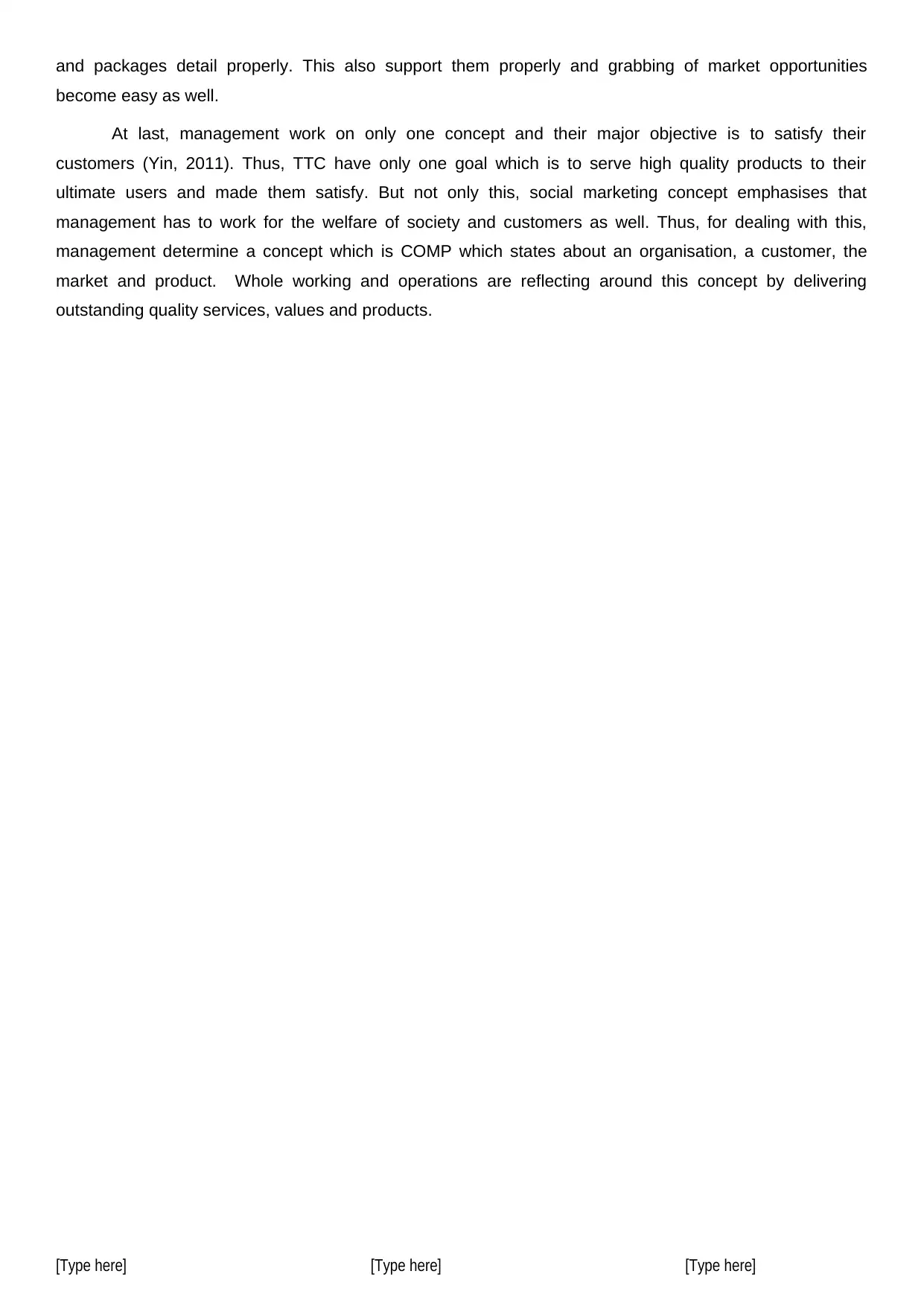
and packages detail properly. This also support them properly and grabbing of market opportunities
become easy as well.
At last, management work on only one concept and their major objective is to satisfy their
customers (Yin, 2011). Thus, TTC have only one goal which is to serve high quality products to their
ultimate users and made them satisfy. But not only this, social marketing concept emphasises that
management has to work for the welfare of society and customers as well. Thus, for dealing with this,
management determine a concept which is COMP which states about an organisation, a customer, the
market and product. Whole working and operations are reflecting around this concept by delivering
outstanding quality services, values and products.
[Type here] [Type here] [Type here]
become easy as well.
At last, management work on only one concept and their major objective is to satisfy their
customers (Yin, 2011). Thus, TTC have only one goal which is to serve high quality products to their
ultimate users and made them satisfy. But not only this, social marketing concept emphasises that
management has to work for the welfare of society and customers as well. Thus, for dealing with this,
management determine a concept which is COMP which states about an organisation, a customer, the
market and product. Whole working and operations are reflecting around this concept by delivering
outstanding quality services, values and products.
[Type here] [Type here] [Type here]
Paraphrase This Document
Need a fresh take? Get an instant paraphrase of this document with our AI Paraphraser
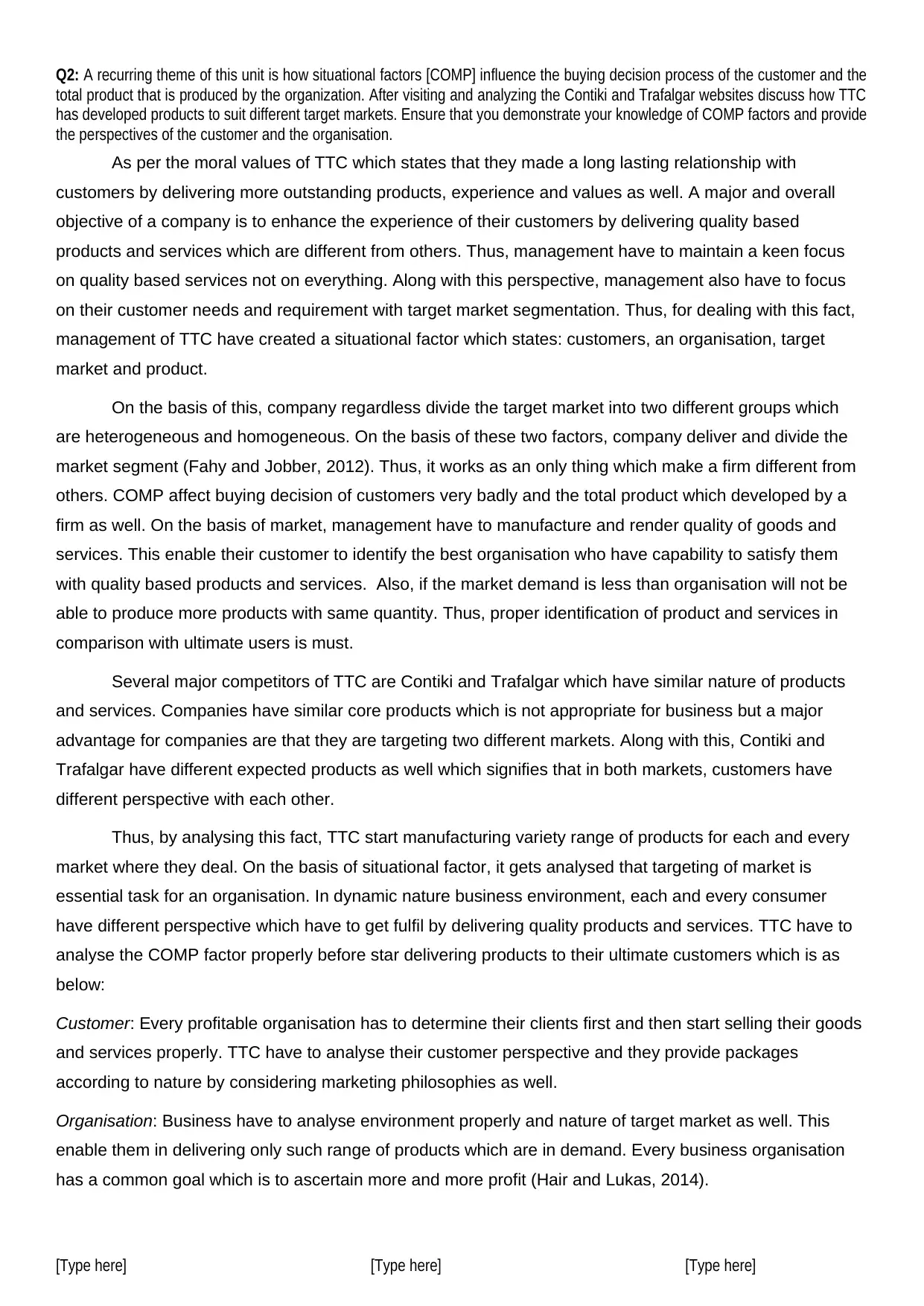
Q2: A recurring theme of this unit is how situational factors [COMP] influence the buying decision process of the customer and the
total product that is produced by the organization. After visiting and analyzing the Contiki and Trafalgar websites discuss how TTC
has developed products to suit different target markets. Ensure that you demonstrate your knowledge of COMP factors and provide
the perspectives of the customer and the organisation.
As per the moral values of TTC which states that they made a long lasting relationship with
customers by delivering more outstanding products, experience and values as well. A major and overall
objective of a company is to enhance the experience of their customers by delivering quality based
products and services which are different from others. Thus, management have to maintain a keen focus
on quality based services not on everything. Along with this perspective, management also have to focus
on their customer needs and requirement with target market segmentation. Thus, for dealing with this fact,
management of TTC have created a situational factor which states: customers, an organisation, target
market and product.
On the basis of this, company regardless divide the target market into two different groups which
are heterogeneous and homogeneous. On the basis of these two factors, company deliver and divide the
market segment (Fahy and Jobber, 2012). Thus, it works as an only thing which make a firm different from
others. COMP affect buying decision of customers very badly and the total product which developed by a
firm as well. On the basis of market, management have to manufacture and render quality of goods and
services. This enable their customer to identify the best organisation who have capability to satisfy them
with quality based products and services. Also, if the market demand is less than organisation will not be
able to produce more products with same quantity. Thus, proper identification of product and services in
comparison with ultimate users is must.
Several major competitors of TTC are Contiki and Trafalgar which have similar nature of products
and services. Companies have similar core products which is not appropriate for business but a major
advantage for companies are that they are targeting two different markets. Along with this, Contiki and
Trafalgar have different expected products as well which signifies that in both markets, customers have
different perspective with each other.
Thus, by analysing this fact, TTC start manufacturing variety range of products for each and every
market where they deal. On the basis of situational factor, it gets analysed that targeting of market is
essential task for an organisation. In dynamic nature business environment, each and every consumer
have different perspective which have to get fulfil by delivering quality products and services. TTC have to
analyse the COMP factor properly before star delivering products to their ultimate customers which is as
below:
Customer: Every profitable organisation has to determine their clients first and then start selling their goods
and services properly. TTC have to analyse their customer perspective and they provide packages
according to nature by considering marketing philosophies as well.
Organisation: Business have to analyse environment properly and nature of target market as well. This
enable them in delivering only such range of products which are in demand. Every business organisation
has a common goal which is to ascertain more and more profit (Hair and Lukas, 2014).
[Type here] [Type here] [Type here]
total product that is produced by the organization. After visiting and analyzing the Contiki and Trafalgar websites discuss how TTC
has developed products to suit different target markets. Ensure that you demonstrate your knowledge of COMP factors and provide
the perspectives of the customer and the organisation.
As per the moral values of TTC which states that they made a long lasting relationship with
customers by delivering more outstanding products, experience and values as well. A major and overall
objective of a company is to enhance the experience of their customers by delivering quality based
products and services which are different from others. Thus, management have to maintain a keen focus
on quality based services not on everything. Along with this perspective, management also have to focus
on their customer needs and requirement with target market segmentation. Thus, for dealing with this fact,
management of TTC have created a situational factor which states: customers, an organisation, target
market and product.
On the basis of this, company regardless divide the target market into two different groups which
are heterogeneous and homogeneous. On the basis of these two factors, company deliver and divide the
market segment (Fahy and Jobber, 2012). Thus, it works as an only thing which make a firm different from
others. COMP affect buying decision of customers very badly and the total product which developed by a
firm as well. On the basis of market, management have to manufacture and render quality of goods and
services. This enable their customer to identify the best organisation who have capability to satisfy them
with quality based products and services. Also, if the market demand is less than organisation will not be
able to produce more products with same quantity. Thus, proper identification of product and services in
comparison with ultimate users is must.
Several major competitors of TTC are Contiki and Trafalgar which have similar nature of products
and services. Companies have similar core products which is not appropriate for business but a major
advantage for companies are that they are targeting two different markets. Along with this, Contiki and
Trafalgar have different expected products as well which signifies that in both markets, customers have
different perspective with each other.
Thus, by analysing this fact, TTC start manufacturing variety range of products for each and every
market where they deal. On the basis of situational factor, it gets analysed that targeting of market is
essential task for an organisation. In dynamic nature business environment, each and every consumer
have different perspective which have to get fulfil by delivering quality products and services. TTC have to
analyse the COMP factor properly before star delivering products to their ultimate customers which is as
below:
Customer: Every profitable organisation has to determine their clients first and then start selling their goods
and services properly. TTC have to analyse their customer perspective and they provide packages
according to nature by considering marketing philosophies as well.
Organisation: Business have to analyse environment properly and nature of target market as well. This
enable them in delivering only such range of products which are in demand. Every business organisation
has a common goal which is to ascertain more and more profit (Hair and Lukas, 2014).
[Type here] [Type here] [Type here]
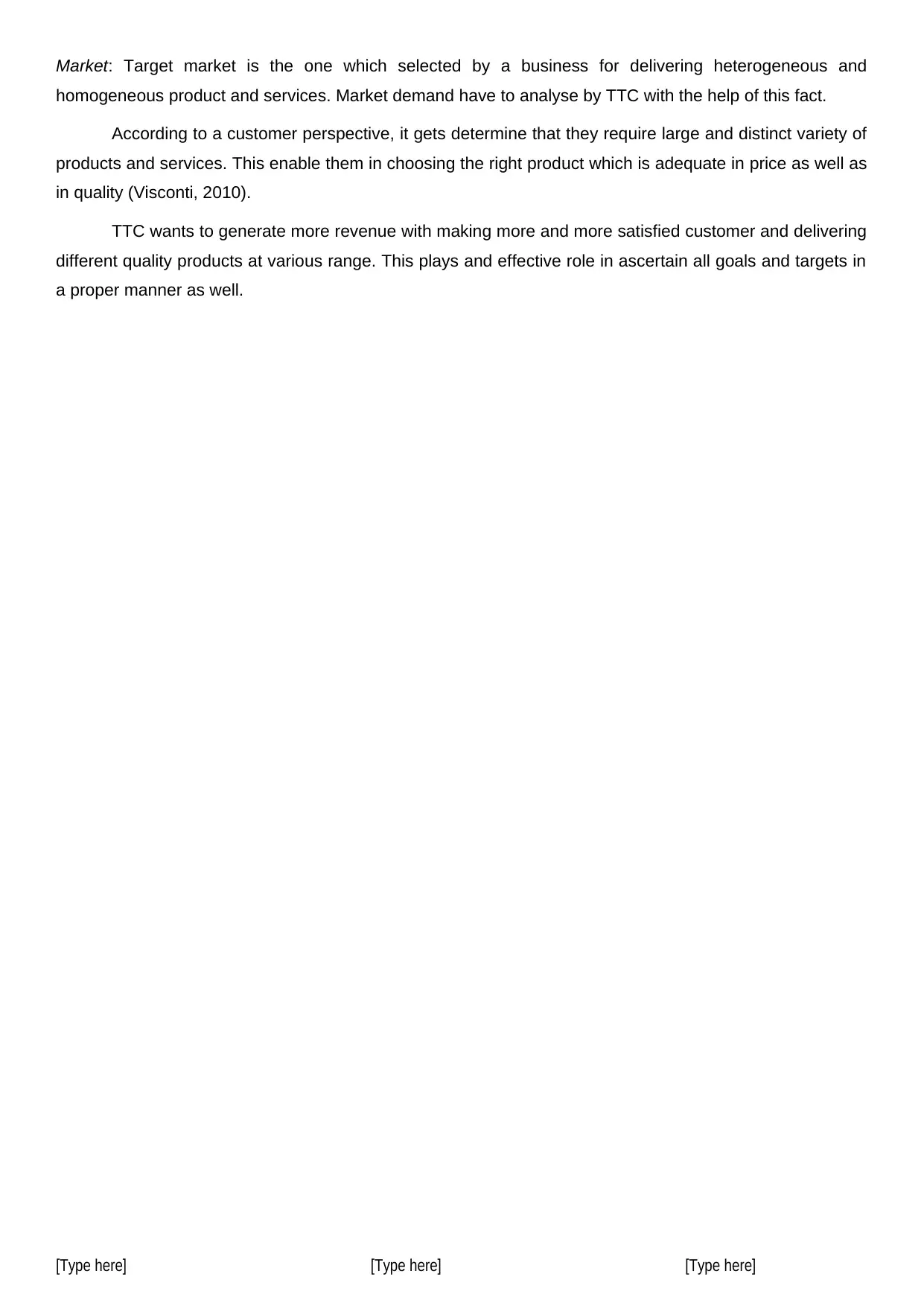
Market: Target market is the one which selected by a business for delivering heterogeneous and
homogeneous product and services. Market demand have to analyse by TTC with the help of this fact.
According to a customer perspective, it gets determine that they require large and distinct variety of
products and services. This enable them in choosing the right product which is adequate in price as well as
in quality (Visconti, 2010).
TTC wants to generate more revenue with making more and more satisfied customer and delivering
different quality products at various range. This plays and effective role in ascertain all goals and targets in
a proper manner as well.
[Type here] [Type here] [Type here]
homogeneous product and services. Market demand have to analyse by TTC with the help of this fact.
According to a customer perspective, it gets determine that they require large and distinct variety of
products and services. This enable them in choosing the right product which is adequate in price as well as
in quality (Visconti, 2010).
TTC wants to generate more revenue with making more and more satisfied customer and delivering
different quality products at various range. This plays and effective role in ascertain all goals and targets in
a proper manner as well.
[Type here] [Type here] [Type here]
⊘ This is a preview!⊘
Do you want full access?
Subscribe today to unlock all pages.

Trusted by 1+ million students worldwide
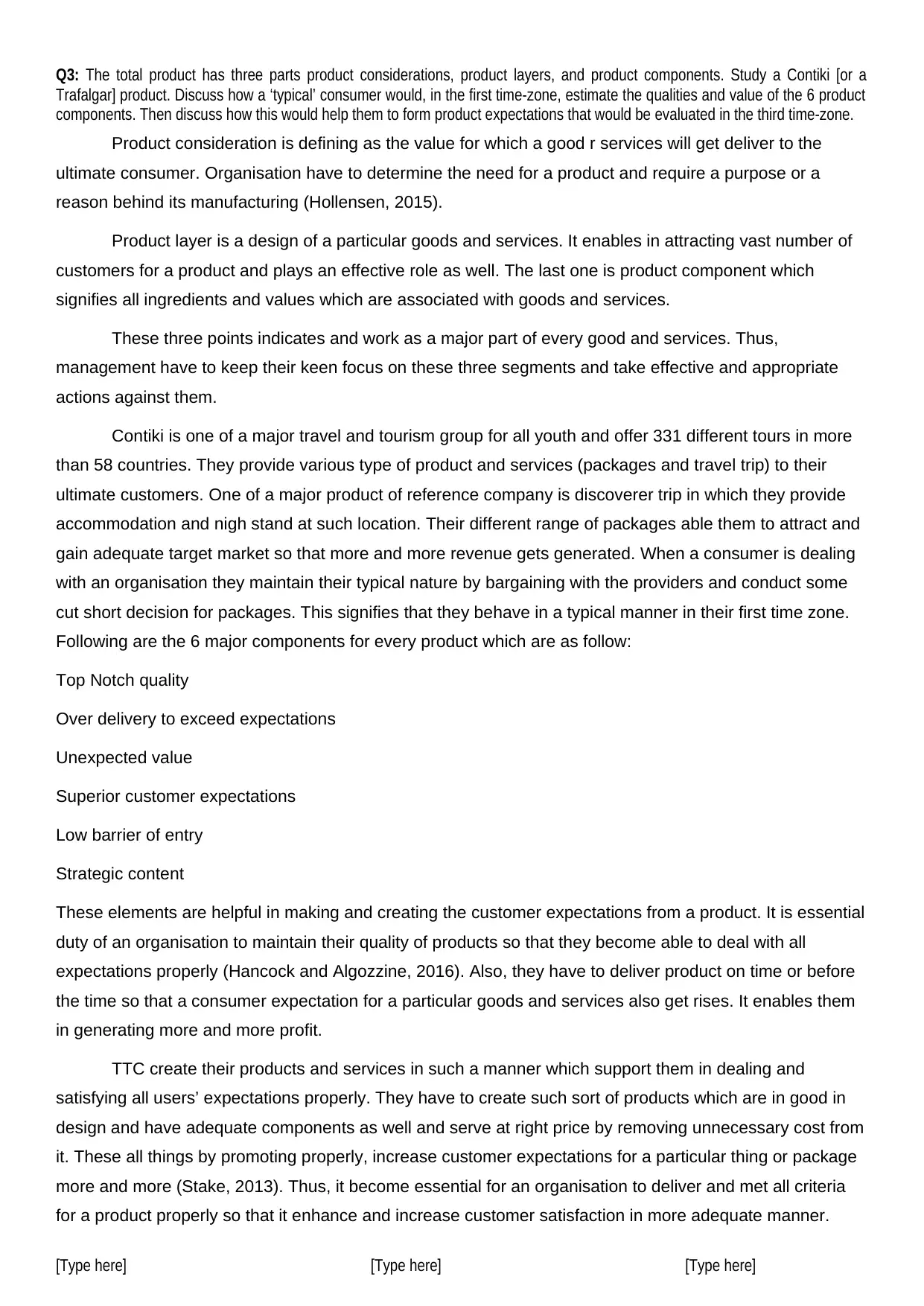
Q3: The total product has three parts product considerations, product layers, and product components. Study a Contiki [or a
Trafalgar] product. Discuss how a ‘typical’ consumer would, in the first time-zone, estimate the qualities and value of the 6 product
components. Then discuss how this would help them to form product expectations that would be evaluated in the third time-zone.
Product consideration is defining as the value for which a good r services will get deliver to the
ultimate consumer. Organisation have to determine the need for a product and require a purpose or a
reason behind its manufacturing (Hollensen, 2015).
Product layer is a design of a particular goods and services. It enables in attracting vast number of
customers for a product and plays an effective role as well. The last one is product component which
signifies all ingredients and values which are associated with goods and services.
These three points indicates and work as a major part of every good and services. Thus,
management have to keep their keen focus on these three segments and take effective and appropriate
actions against them.
Contiki is one of a major travel and tourism group for all youth and offer 331 different tours in more
than 58 countries. They provide various type of product and services (packages and travel trip) to their
ultimate customers. One of a major product of reference company is discoverer trip in which they provide
accommodation and nigh stand at such location. Their different range of packages able them to attract and
gain adequate target market so that more and more revenue gets generated. When a consumer is dealing
with an organisation they maintain their typical nature by bargaining with the providers and conduct some
cut short decision for packages. This signifies that they behave in a typical manner in their first time zone.
Following are the 6 major components for every product which are as follow:
Top Notch quality
Over delivery to exceed expectations
Unexpected value
Superior customer expectations
Low barrier of entry
Strategic content
These elements are helpful in making and creating the customer expectations from a product. It is essential
duty of an organisation to maintain their quality of products so that they become able to deal with all
expectations properly (Hancock and Algozzine, 2016). Also, they have to deliver product on time or before
the time so that a consumer expectation for a particular goods and services also get rises. It enables them
in generating more and more profit.
TTC create their products and services in such a manner which support them in dealing and
satisfying all users’ expectations properly. They have to create such sort of products which are in good in
design and have adequate components as well and serve at right price by removing unnecessary cost from
it. These all things by promoting properly, increase customer expectations for a particular thing or package
more and more (Stake, 2013). Thus, it become essential for an organisation to deliver and met all criteria
for a product properly so that it enhance and increase customer satisfaction in more adequate manner.
[Type here] [Type here] [Type here]
Trafalgar] product. Discuss how a ‘typical’ consumer would, in the first time-zone, estimate the qualities and value of the 6 product
components. Then discuss how this would help them to form product expectations that would be evaluated in the third time-zone.
Product consideration is defining as the value for which a good r services will get deliver to the
ultimate consumer. Organisation have to determine the need for a product and require a purpose or a
reason behind its manufacturing (Hollensen, 2015).
Product layer is a design of a particular goods and services. It enables in attracting vast number of
customers for a product and plays an effective role as well. The last one is product component which
signifies all ingredients and values which are associated with goods and services.
These three points indicates and work as a major part of every good and services. Thus,
management have to keep their keen focus on these three segments and take effective and appropriate
actions against them.
Contiki is one of a major travel and tourism group for all youth and offer 331 different tours in more
than 58 countries. They provide various type of product and services (packages and travel trip) to their
ultimate customers. One of a major product of reference company is discoverer trip in which they provide
accommodation and nigh stand at such location. Their different range of packages able them to attract and
gain adequate target market so that more and more revenue gets generated. When a consumer is dealing
with an organisation they maintain their typical nature by bargaining with the providers and conduct some
cut short decision for packages. This signifies that they behave in a typical manner in their first time zone.
Following are the 6 major components for every product which are as follow:
Top Notch quality
Over delivery to exceed expectations
Unexpected value
Superior customer expectations
Low barrier of entry
Strategic content
These elements are helpful in making and creating the customer expectations from a product. It is essential
duty of an organisation to maintain their quality of products so that they become able to deal with all
expectations properly (Hancock and Algozzine, 2016). Also, they have to deliver product on time or before
the time so that a consumer expectation for a particular goods and services also get rises. It enables them
in generating more and more profit.
TTC create their products and services in such a manner which support them in dealing and
satisfying all users’ expectations properly. They have to create such sort of products which are in good in
design and have adequate components as well and serve at right price by removing unnecessary cost from
it. These all things by promoting properly, increase customer expectations for a particular thing or package
more and more (Stake, 2013). Thus, it become essential for an organisation to deliver and met all criteria
for a product properly so that it enhance and increase customer satisfaction in more adequate manner.
[Type here] [Type here] [Type here]
Paraphrase This Document
Need a fresh take? Get an instant paraphrase of this document with our AI Paraphraser
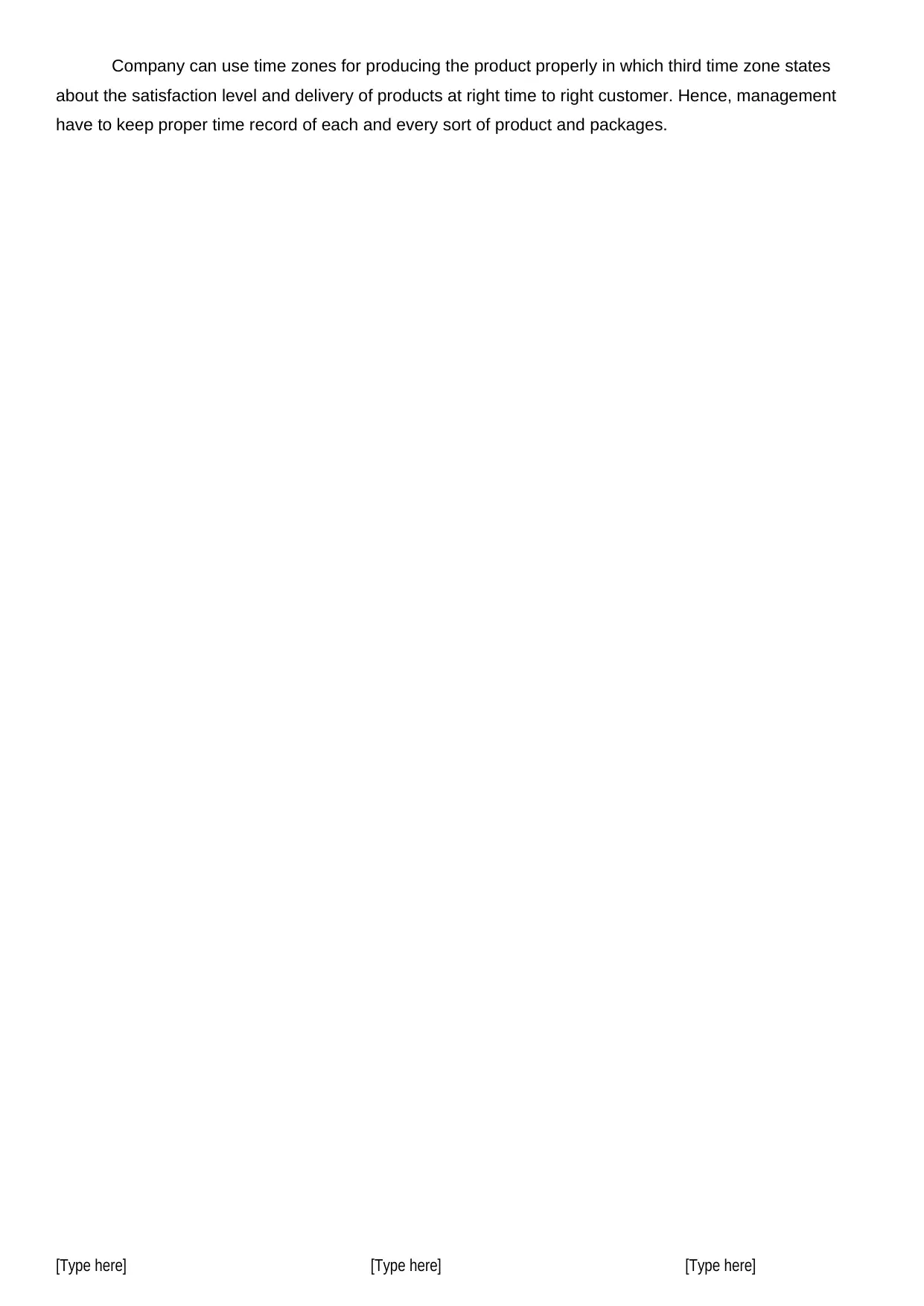
Company can use time zones for producing the product properly in which third time zone states
about the satisfaction level and delivery of products at right time to right customer. Hence, management
have to keep proper time record of each and every sort of product and packages.
[Type here] [Type here] [Type here]
about the satisfaction level and delivery of products at right time to right customer. Hence, management
have to keep proper time record of each and every sort of product and packages.
[Type here] [Type here] [Type here]
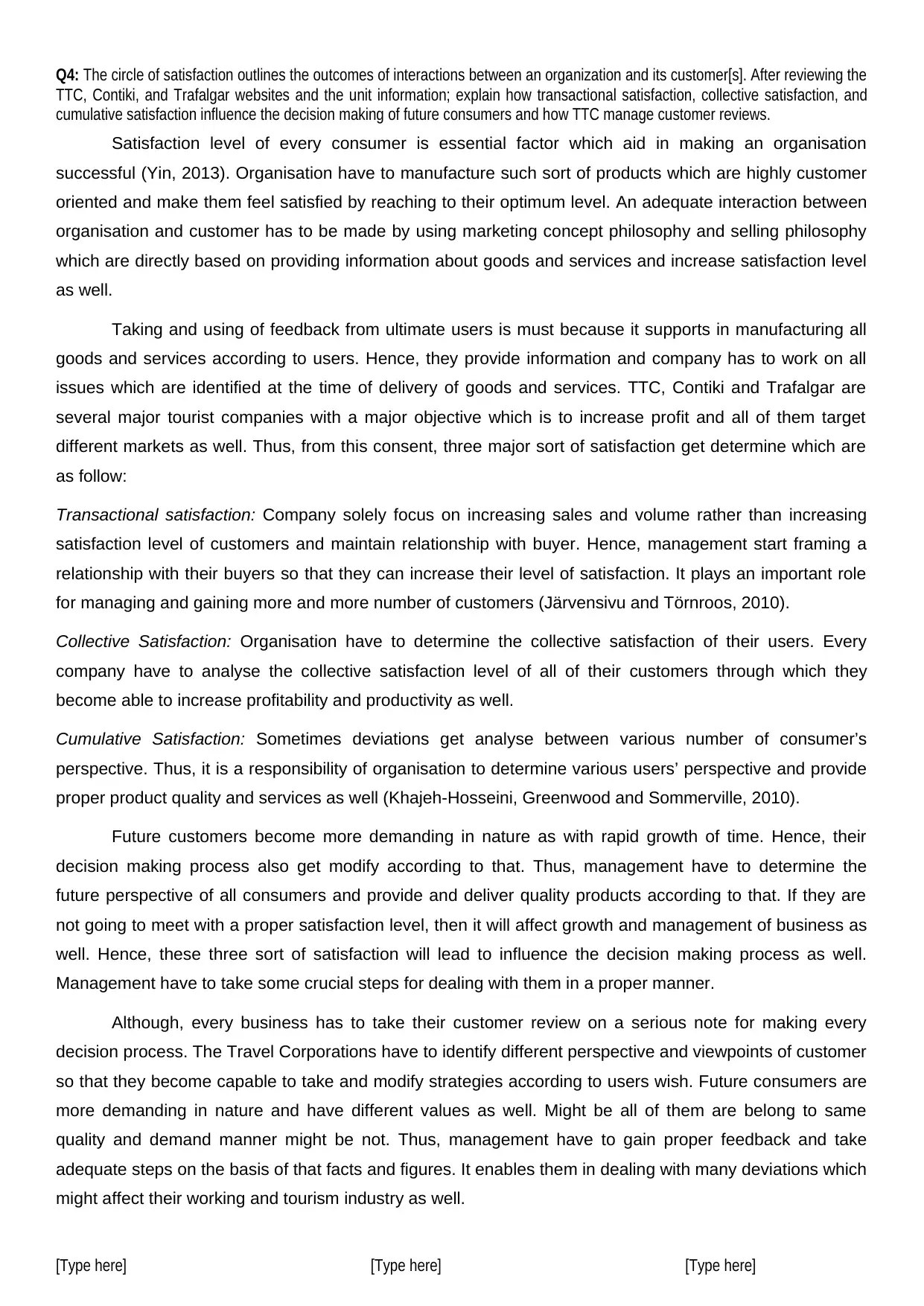
Q4: The circle of satisfaction outlines the outcomes of interactions between an organization and its customer[s]. After reviewing the
TTC, Contiki, and Trafalgar websites and the unit information; explain how transactional satisfaction, collective satisfaction, and
cumulative satisfaction influence the decision making of future consumers and how TTC manage customer reviews.
Satisfaction level of every consumer is essential factor which aid in making an organisation
successful (Yin, 2013). Organisation have to manufacture such sort of products which are highly customer
oriented and make them feel satisfied by reaching to their optimum level. An adequate interaction between
organisation and customer has to be made by using marketing concept philosophy and selling philosophy
which are directly based on providing information about goods and services and increase satisfaction level
as well.
Taking and using of feedback from ultimate users is must because it supports in manufacturing all
goods and services according to users. Hence, they provide information and company has to work on all
issues which are identified at the time of delivery of goods and services. TTC, Contiki and Trafalgar are
several major tourist companies with a major objective which is to increase profit and all of them target
different markets as well. Thus, from this consent, three major sort of satisfaction get determine which are
as follow:
Transactional satisfaction: Company solely focus on increasing sales and volume rather than increasing
satisfaction level of customers and maintain relationship with buyer. Hence, management start framing a
relationship with their buyers so that they can increase their level of satisfaction. It plays an important role
for managing and gaining more and more number of customers (Järvensivu and Törnroos, 2010).
Collective Satisfaction: Organisation have to determine the collective satisfaction of their users. Every
company have to analyse the collective satisfaction level of all of their customers through which they
become able to increase profitability and productivity as well.
Cumulative Satisfaction: Sometimes deviations get analyse between various number of consumer’s
perspective. Thus, it is a responsibility of organisation to determine various users’ perspective and provide
proper product quality and services as well (Khajeh-Hosseini, Greenwood and Sommerville, 2010).
Future customers become more demanding in nature as with rapid growth of time. Hence, their
decision making process also get modify according to that. Thus, management have to determine the
future perspective of all consumers and provide and deliver quality products according to that. If they are
not going to meet with a proper satisfaction level, then it will affect growth and management of business as
well. Hence, these three sort of satisfaction will lead to influence the decision making process as well.
Management have to take some crucial steps for dealing with them in a proper manner.
Although, every business has to take their customer review on a serious note for making every
decision process. The Travel Corporations have to identify different perspective and viewpoints of customer
so that they become capable to take and modify strategies according to users wish. Future consumers are
more demanding in nature and have different values as well. Might be all of them are belong to same
quality and demand manner might be not. Thus, management have to gain proper feedback and take
adequate steps on the basis of that facts and figures. It enables them in dealing with many deviations which
might affect their working and tourism industry as well.
[Type here] [Type here] [Type here]
TTC, Contiki, and Trafalgar websites and the unit information; explain how transactional satisfaction, collective satisfaction, and
cumulative satisfaction influence the decision making of future consumers and how TTC manage customer reviews.
Satisfaction level of every consumer is essential factor which aid in making an organisation
successful (Yin, 2013). Organisation have to manufacture such sort of products which are highly customer
oriented and make them feel satisfied by reaching to their optimum level. An adequate interaction between
organisation and customer has to be made by using marketing concept philosophy and selling philosophy
which are directly based on providing information about goods and services and increase satisfaction level
as well.
Taking and using of feedback from ultimate users is must because it supports in manufacturing all
goods and services according to users. Hence, they provide information and company has to work on all
issues which are identified at the time of delivery of goods and services. TTC, Contiki and Trafalgar are
several major tourist companies with a major objective which is to increase profit and all of them target
different markets as well. Thus, from this consent, three major sort of satisfaction get determine which are
as follow:
Transactional satisfaction: Company solely focus on increasing sales and volume rather than increasing
satisfaction level of customers and maintain relationship with buyer. Hence, management start framing a
relationship with their buyers so that they can increase their level of satisfaction. It plays an important role
for managing and gaining more and more number of customers (Järvensivu and Törnroos, 2010).
Collective Satisfaction: Organisation have to determine the collective satisfaction of their users. Every
company have to analyse the collective satisfaction level of all of their customers through which they
become able to increase profitability and productivity as well.
Cumulative Satisfaction: Sometimes deviations get analyse between various number of consumer’s
perspective. Thus, it is a responsibility of organisation to determine various users’ perspective and provide
proper product quality and services as well (Khajeh-Hosseini, Greenwood and Sommerville, 2010).
Future customers become more demanding in nature as with rapid growth of time. Hence, their
decision making process also get modify according to that. Thus, management have to determine the
future perspective of all consumers and provide and deliver quality products according to that. If they are
not going to meet with a proper satisfaction level, then it will affect growth and management of business as
well. Hence, these three sort of satisfaction will lead to influence the decision making process as well.
Management have to take some crucial steps for dealing with them in a proper manner.
Although, every business has to take their customer review on a serious note for making every
decision process. The Travel Corporations have to identify different perspective and viewpoints of customer
so that they become capable to take and modify strategies according to users wish. Future consumers are
more demanding in nature and have different values as well. Might be all of them are belong to same
quality and demand manner might be not. Thus, management have to gain proper feedback and take
adequate steps on the basis of that facts and figures. It enables them in dealing with many deviations which
might affect their working and tourism industry as well.
[Type here] [Type here] [Type here]
⊘ This is a preview!⊘
Do you want full access?
Subscribe today to unlock all pages.

Trusted by 1+ million students worldwide
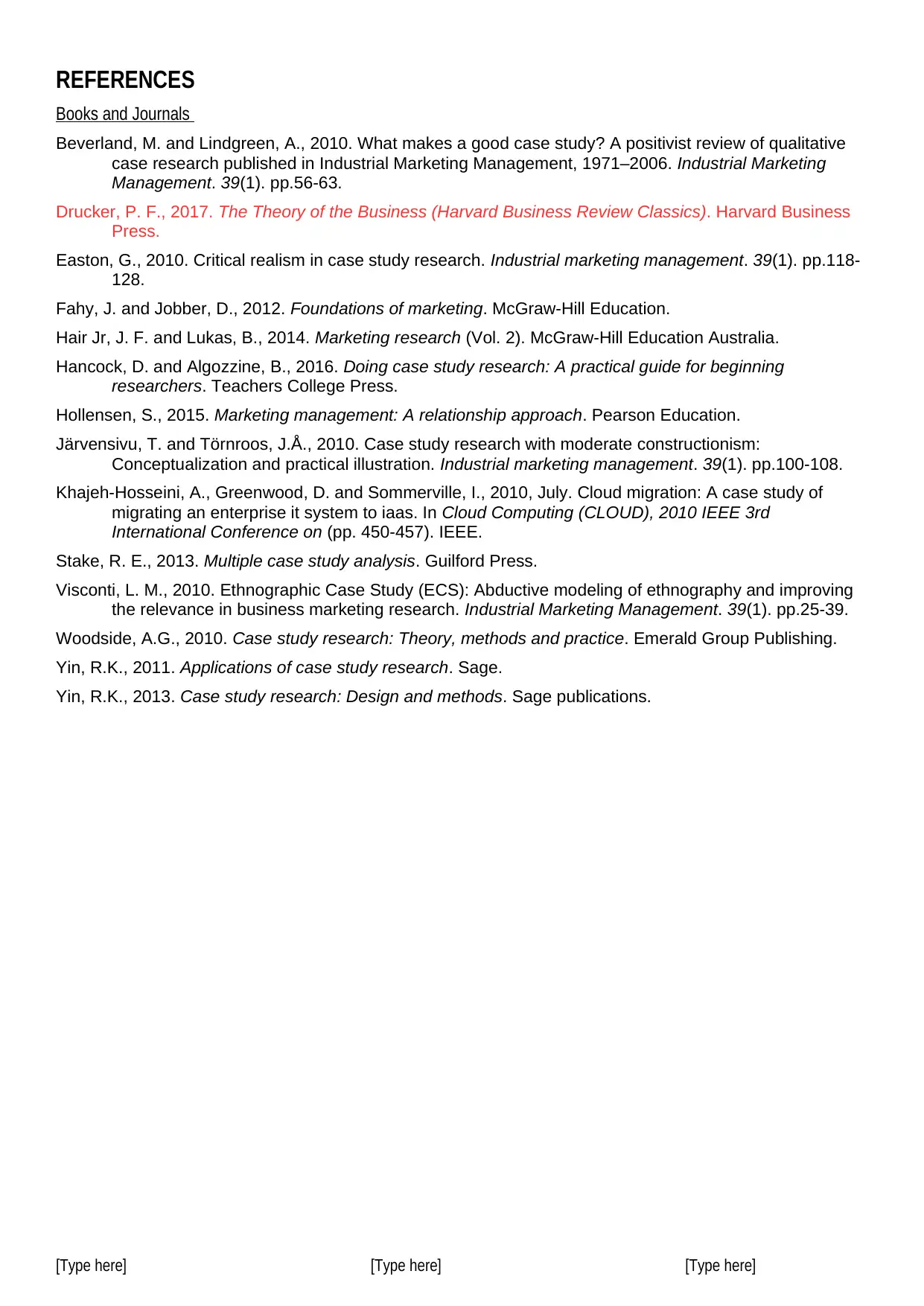
REFERENCES
Books and Journals
Beverland, M. and Lindgreen, A., 2010. What makes a good case study? A positivist review of qualitative
case research published in Industrial Marketing Management, 1971–2006. Industrial Marketing
Management. 39(1). pp.56-63.
Drucker, P. F., 2017. The Theory of the Business (Harvard Business Review Classics). Harvard Business
Press.
Easton, G., 2010. Critical realism in case study research. Industrial marketing management. 39(1). pp.118-
128.
Fahy, J. and Jobber, D., 2012. Foundations of marketing. McGraw-Hill Education.
Hair Jr, J. F. and Lukas, B., 2014. Marketing research (Vol. 2). McGraw-Hill Education Australia.
Hancock, D. and Algozzine, B., 2016. Doing case study research: A practical guide for beginning
researchers. Teachers College Press.
Hollensen, S., 2015. Marketing management: A relationship approach. Pearson Education.
Järvensivu, T. and Törnroos, J.Å., 2010. Case study research with moderate constructionism:
Conceptualization and practical illustration. Industrial marketing management. 39(1). pp.100-108.
Khajeh-Hosseini, A., Greenwood, D. and Sommerville, I., 2010, July. Cloud migration: A case study of
migrating an enterprise it system to iaas. In Cloud Computing (CLOUD), 2010 IEEE 3rd
International Conference on (pp. 450-457). IEEE.
Stake, R. E., 2013. Multiple case study analysis. Guilford Press.
Visconti, L. M., 2010. Ethnographic Case Study (ECS): Abductive modeling of ethnography and improving
the relevance in business marketing research. Industrial Marketing Management. 39(1). pp.25-39.
Woodside, A.G., 2010. Case study research: Theory, methods and practice. Emerald Group Publishing.
Yin, R.K., 2011. Applications of case study research. Sage.
Yin, R.K., 2013. Case study research: Design and methods. Sage publications.
[Type here] [Type here] [Type here]
Books and Journals
Beverland, M. and Lindgreen, A., 2010. What makes a good case study? A positivist review of qualitative
case research published in Industrial Marketing Management, 1971–2006. Industrial Marketing
Management. 39(1). pp.56-63.
Drucker, P. F., 2017. The Theory of the Business (Harvard Business Review Classics). Harvard Business
Press.
Easton, G., 2010. Critical realism in case study research. Industrial marketing management. 39(1). pp.118-
128.
Fahy, J. and Jobber, D., 2012. Foundations of marketing. McGraw-Hill Education.
Hair Jr, J. F. and Lukas, B., 2014. Marketing research (Vol. 2). McGraw-Hill Education Australia.
Hancock, D. and Algozzine, B., 2016. Doing case study research: A practical guide for beginning
researchers. Teachers College Press.
Hollensen, S., 2015. Marketing management: A relationship approach. Pearson Education.
Järvensivu, T. and Törnroos, J.Å., 2010. Case study research with moderate constructionism:
Conceptualization and practical illustration. Industrial marketing management. 39(1). pp.100-108.
Khajeh-Hosseini, A., Greenwood, D. and Sommerville, I., 2010, July. Cloud migration: A case study of
migrating an enterprise it system to iaas. In Cloud Computing (CLOUD), 2010 IEEE 3rd
International Conference on (pp. 450-457). IEEE.
Stake, R. E., 2013. Multiple case study analysis. Guilford Press.
Visconti, L. M., 2010. Ethnographic Case Study (ECS): Abductive modeling of ethnography and improving
the relevance in business marketing research. Industrial Marketing Management. 39(1). pp.25-39.
Woodside, A.G., 2010. Case study research: Theory, methods and practice. Emerald Group Publishing.
Yin, R.K., 2011. Applications of case study research. Sage.
Yin, R.K., 2013. Case study research: Design and methods. Sage publications.
[Type here] [Type here] [Type here]
1 out of 10
Related Documents
Your All-in-One AI-Powered Toolkit for Academic Success.
+13062052269
info@desklib.com
Available 24*7 on WhatsApp / Email
![[object Object]](/_next/static/media/star-bottom.7253800d.svg)
Unlock your academic potential
Copyright © 2020–2025 A2Z Services. All Rights Reserved. Developed and managed by ZUCOL.





